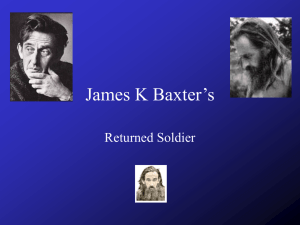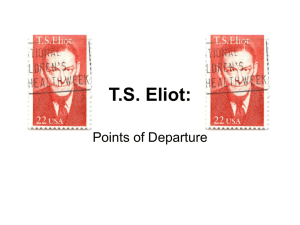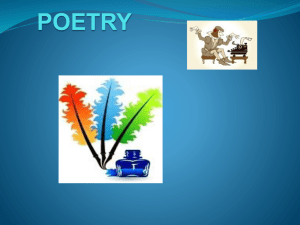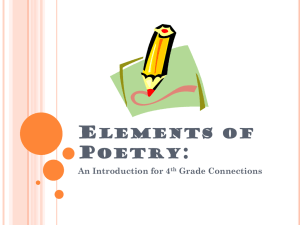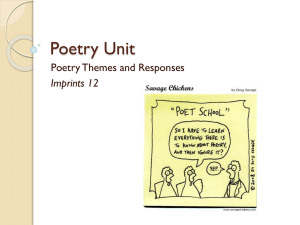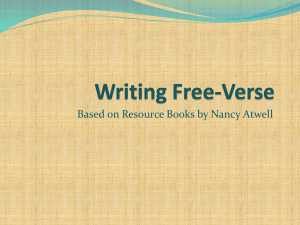30. Appreciating Poetry Packet
advertisement
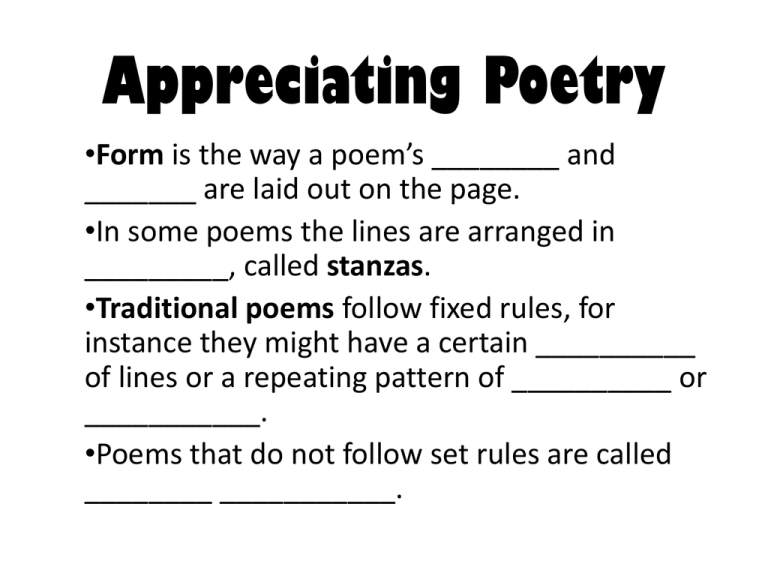
Appreciating Poetry •Form is the way a poem’s ________ and _______ are laid out on the page. •In some poems the lines are arranged in _________, called stanzas. •Traditional poems follow fixed rules, for instance they might have a certain __________ of lines or a repeating pattern of __________ or ___________. •Poems that do not follow set rules are called ________ ___________. Appreciating Poetry A Traditional Poem: A Minor Bird by Robert Frost I have wished a bird would fly away, And not sing by my house all day; Circle the stanzas. Have clapped my hands at him from the door When it seemed as if I could bear no more. Highlight each pair of rhyming words with a different color. The fault must partly have been in me, The bird was not to blame for his key, And of course there must be something wrong In wanting to silence any song. Appreciating Poetry A Free Verse Poem: Under the Back Porch by Virginia Hamilton As you listen to the poem, draw what you visualize. Circle the stanzas. Our house is two stories high Shaped like a white box. There is a yard stretched around it And in back A wooden porch. Under the back porch us my place. I rest there. I go there when I have to be alone. It is always shaded and damp. Sunlight only slants through the slats In long strips of light, And the smell of the damp Is moist green, Like the moss that grows here. My sisters and brothers Can stand on the back porch And never know I am here Underneath. It is my place. All mine. What do you learn about the speaker of this poem? What effect does the short length of the last four lines create? Appreciating Poetry UNDER THE BACK PORCH - PICTURE Appreciating Poetry Sound Devices: • Rhyme – the repetition of sounds as the ______ of words, as in me and see. • Rhythm – the pattern of ________ and ________ syllables in each line. • Repetition – the use of a word, phrase, or line more than __________. • Alliteration – the repetition of consonant sounds at the __________ of words, such as the c in curved crook. Appreciating Poetry How thin and sharp is the moon tonight! How thin and sharp and ghostly white Is the slim curved crook of the moon tonight! Underline the repeated phrases. Circle the rhyming words. Put a box around the example of alliteration. Appreciating Poetry A word is dead by Emily Dickinson A word is dead When it is said, Some say. Draw a box around each stanza. Circle the rhyming words. I say it just Begins to live That day. Mark the pattern of stressed and unstressed syllables that create rhythm in the second stanza. Appreciating Poetry Sound Devices: • Onomatopoeia – the use of words (made up or real) whose __________ suggest their ___________. • Examples: achoo, bong, boom, bubble, clank, fizz, hiss, knock, hiccup, meow • Come up with 3 more on your own: – – – Appreciating Poetry Cynthia in the Snow by Gwendolyn Brooks It SUSHES. It hushes The loudness of the road. It flitter-twitters, And laughs away from me. It laughs a lovely whiteness, And whitely whirs away, To be Some otherwhere, Still white as milk or shirts So beautiful it hurts. Highlight the onomatopoeic words that the poet uses to suggest the silencing effect of falling snow. Put a box around the examples of alliteration. Circle three pairs of rhyming words. Appreciating Poetry Imagery and Figurative Language (Review): • Simile – a comparison between two unlike things, using the words like or as • Metaphor – a comparison between two unlike things that does not contain the word like or as (saying one thing IS another). • Personification – a description of an object, an animal, a place, or an idea as if it were human or had human qualities. Appreciating Poetry Example 1: He’s white As spilled milk, My cat who sleeps With his belly Turned toward The summer sky. Example 2: Fame is a bee. It has a song – It has a sting – Ah, too, it has a wing. Example 3: Look out how you use proud words. When you let proud words go, it is Not easy to call them back. They wear long boots, hard boots; they Walk off proud; they can’t hear you Calling – Look out how you use proud words. Circle a simile. Draw a box around a metaphor. Highlight the examples of personification. Appreciating Poetry The Poet Inside You Project Due Dates: Assignment #1 – Tuesday, April 24th • Acrostic and Alliteration Poem Assignment #2 – Friday, April 27th • Couplet and Free Verse Assignment #3 – Tuesday, May 1st • Narrative Assignment #4 – Friday, May 3rd • Haiku, Cinquain, and Tanka Assignment #5 – Tuesday, May 7th • Limerick and Shape Other important dates: POETRY Test on Wednesday, May 8th The Poet Inside You POETRY BOOK (all poems edited, typed, and bound) due on Friday, May 10th
